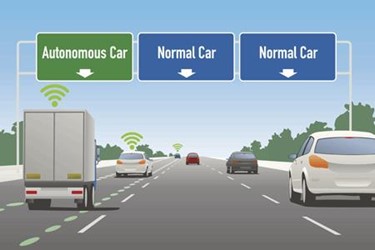Metawave Set To Unveil Analog-Based Radar For Autonomous Vehicles
By Jof Enriquez,
Follow me on Twitter @jofenriq

Wireless technology startup Metawave says its analog-based radar platform, made of engineered metamaterials with embedded artificial intelligence, will allow autonomous vehicles make better sense of their surroundings. This technology has the potential to disrupt the automotive radar market, according to the company.
Metawave's WARLORD (W-band Advanced Radar for Long-range Object Recognition and Detection) radar utilizes a single electronically steerable antenna that can steer and shape a highly directional pencil beam in the horizontal and vertical direction, and adjust the beam from a wider field of view to a very narrow view, down to one degree. The company says this results in a longer range, as well as better discrimination of objects, which can be viewed in "true 3D vision."
By contrast, conventional automotive radar using digital beamforming (DBF) technology “cannot focus the beam to a very narrow angle in the eight degrees to 10 degrees beam width,” Mahar Achour, Metawave CEO, told R&D Magazine. “On the steering part, in the far field, the digital beamforming has difficulty steering the beam beyond maybe six to seven degrees, so it has very a limited field of view and it can only steer in the horizontal direction.”
“It cannot tell you if it is a car or a motorcycle, it cannot discriminate between different objects,” she added. “Electronically we are able to shape the beam down to a one-degree beam, be able to steer the beam plus or minus 50 degrees at 250 meters both in the horizontal and vertical direction, all while being able to steer it at microsecond speed.”
This faster speed of operation and precise control of the radar beam is made possible by company-developed metamaterials, which mimic larger and more expensive phased array antennas used by the United States military.
Metawave added to its radar's level of sophistication by embedding an AI engine (WRATH: Warlord AI Thinking like Humans) consisting of “range-Doppler estimation algorithms, clutter and jammer suppression algorithms, object detection and tracking algorithms, other proprietary electromagnetic and radar codes, in addition to deep learning and decision-making algorithms,” Metawave CTO Bernard Casse told EE Times.
While some experts believe that LIDAR (Light Detection and Ranging) systems in self-driving cars still is superior in resolution and localization, Achour believes that Metawave’s analog radar, in conjunction with digital maps, “will be sufficient to provide precise localization,” according to the publication.
She adds, “As the AI engines mature, digital maps become more available and precise, and even in the absence of V2X [vehicle-to-everything] communication, the radar and camera will be sufficient to let cars drive themselves with zero incidents.”
Palo Alto-based Metawave will demonstrate a prototype of its metamaterial-based analog automotive radar at the Consumer Electronics Show in January 2018.
Spun out of PARC in August, Metawave last month raised $7 million in seed capital to commercialize smart radar platforms for autonomous vehicles – including general Advanced Driver Assistance Systems (ADAS), and plans to offer its radar and antenna technologies for 5G wireless providers.
Metawave is working with global telecommunications infrastructure vendors and service providers to accelerate 5G deployments. Specifically, it is offering cellular networks its Metamaterial Frequency-Adaptive Steering Technology (M-FAST) platform, which enables networks to support a massive number of devices that demand more bandwidth.
The company will showcase its smart beamforming antenna technology for 5G networks at the Mobile World Congress in Barcelona next February.
